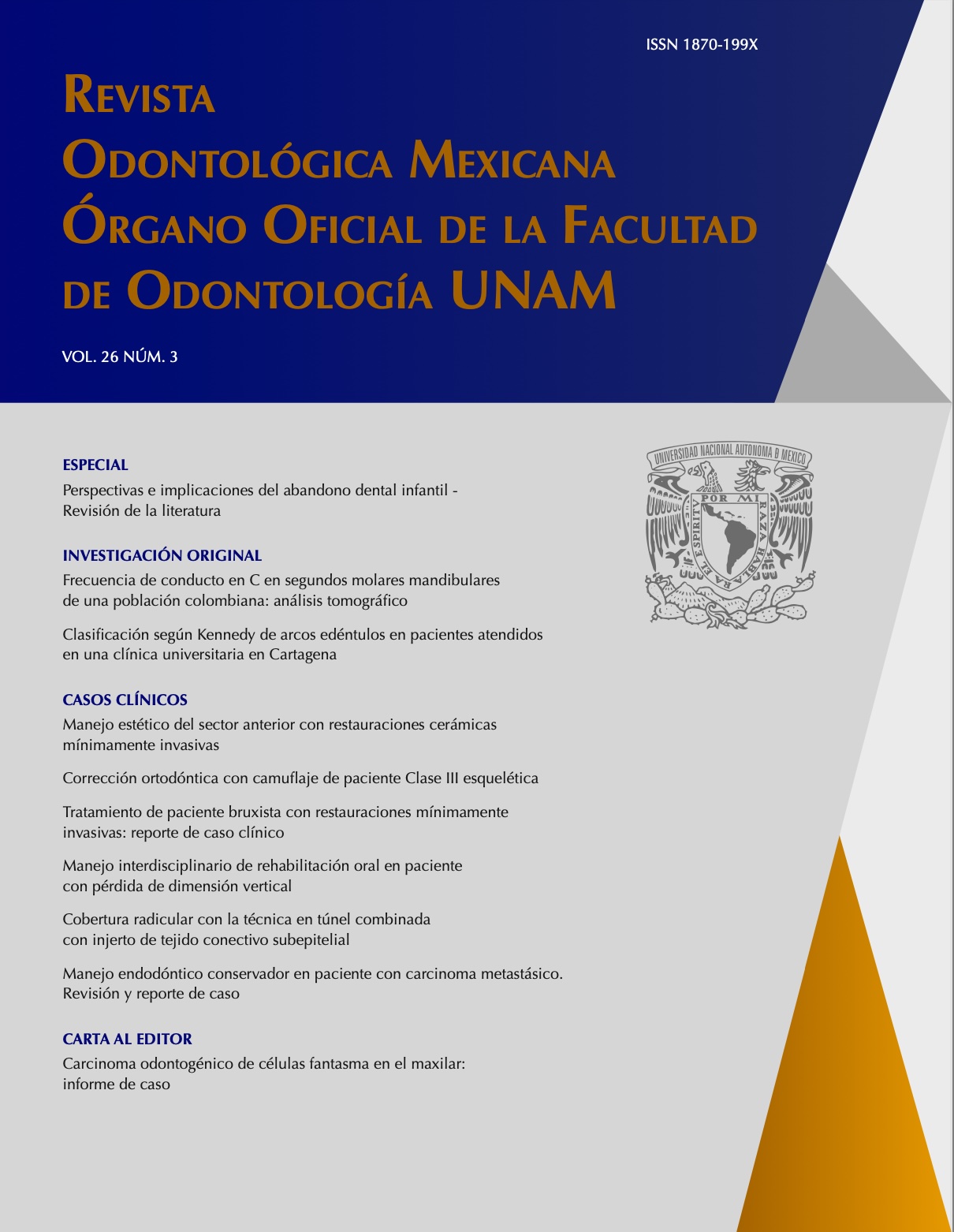Kennedy Classification of Edentulous Arches in Patients Treated at a University Clinic in Cartagena
Main Article Content
Abstract
Introduction: Edentulism is a public health problem caused by the accumulation of oral pathologies, affecting both the elderly population and the young population in unfavourable social conditions, causing negative effects on facial appearance, nutrition, and the abilities to eat, speak and socialise. Partial edentulism implies the absence of one or more teeth; this is classified according to the Kennedy method which is the most accepted among the dental community. Objective: To characterise partially edentulous dental arches in patients treated at a university dental clinic in Cartagena from 2015 to 2018. Material and Methods: A descriptive cross-sectional study was carried out using medical records. The sample was obtained using selection criteria. The current regulations for Colombia and the Declaration of Helsinki were considered; requests were made for ethics approval and for permission to access the clinical archives. To collect the information, a registration form was designed and validated, used by four previously trained students. The descriptive analysis and the chi–square test, were developed using ibm® spss® Statistics software, version 11. Results: A total of 130 medical records were reviewed, of which 111 met the selection criteria. The female sex predominated with almost 75% of the clinical histories included. The most frequent reason for consultation was aesthetics, approaching 80%. Edentulism occurred in 47% in the mandible (95% CI: 37.31-56.55), followed by Bimaxillary edentulism. A statistically significant relationship was found with age, for the group of 46 to 63 years old with mandibular Class I according to Kennedy classification. Conclusion: The predominant type of partially edentulous dental arch was Class III in the maxilla and Class I in the mandible, according to Kennedy classification. There was no association between gender, the type of partial edentulism and the classification of the dental arches.
Article Details
Citas en Dimensions Service
References
Organización Mundial de la Salud. Salud bucodental. 2018. [Consultado noviembre 7, 2023]. Disponible en: https://www.who.int/es/news-room/fact-sheets/detail/oral-health
Tyrovolas S, Koyanagi A, Panagiotakos DB, Haro JM, Kassebaum NJ, Chrepa V, et al. Population prevalence of edentulism and its association with depression and self-rated health. Sci Rep. 2016; 6: 37083. DOI: 10.1038/srep37083
Chumpitaz-Durand R, Lecca Gonzalez M, Diaz Torres C. Prevalence of partial edentulism according to Kennedy and Applegate in patients treated at a university dental clinic in Lambayeque-Peru. J Oral Res. 2019; 8(3):236-243. DOI: 10.17126/joralres.2019.035
Al-Rafee MA. The epidemiology of edentulism and the associated factors: A literature Review. J Family Med Prim Care. 2020; 9(4):1841-1843. DOI: 10.4103/jfmpc.jfmpc_1181_19
Maia LC, Costa SM, Martelli DRB, Caldeira AP. Edentulismo total em idosos: envelhecimento ou desigualdade social? Rev Bioét. 2020; 28(1):173-181. DOI: 10.1590/1983-80422020281380
Escudero E, Muñoz VM, De La Cruz Claure ML, Aprili Justiniano L, Valda Mobarec EY. Prevalencia del edentulismo parcial y total, su impacto en la calidad de vida de la población de 15 a 85 años de Sucre, 2019. Rev Cien Tec In. 2020; 18(21):161-190. http://www.scielo.org.bo/scielo.php?pid=S2225-87872020000100007&script=sci_arttext
Kumar B, Kumar N, Ali S, Ahmed S. Partial edentulism; exploring partial edentulism patterns in mandibular arch among patients of Karachi. Professional Med J. 2019; 26(5):764-768. DOI: 10.29309/TPMJ/2019.26.05.3474
Lone MA, Shah SA, Mir S. Pattern of partial edentulism based on Kennedys classification among dental patients in Kashmir: retrospective study. International Journal of Applied Dental Sciences. 2019; 5(2):209-212. https://www.oraljournal.com/pdf/2019/vol5issue2/PartD/5-2-18-277.pdf
Kennedy EDDS. Partial denture construction. 2 ed. Brooklyn, NY: Dental Items of Interest, 1951.
MINSALUD. Estudio Nacional de Salud Bucal ENSAB IV. Situación en Salud Bucal. [Internet]. [Consultado 7 noviembre 2023]. Disponible en: https://www.minsalud.gov.co/sites/rid/Lists/BibliotecaDigital/RIDE/VS/PP/ENSAB-IV-Situacion-Bucal-Actual.pdf
Díaz-Cárdenas S, Tirado-Amador L, Tamayo-Cabeza G. Impacto de la sonrisa sobre calidad de vida relacionada con salud bucal en adultos. Rev. Clín. Periodoncia Implantol. Rehabil. Oral. 2018; 11(2):78-83. DOI: 10.4067/S0719-01072018000200078
Fouda SM, Al-Harbi FA, Khan SQ, Virtanen JI, Raustia A. Missing teeth and prosthetic treatment in patients treated at College of Dentistry, University of Dammam. Int J Dent. 2017: 7593540. DOI: 10.1155/2017/7593540
Almusallam SM, AlRafee MA. The prevalence of partial edentulism and complete edentulism among adults and above population of Riyadh city in Saudi Arabia. J Family Med Prim Care. 2020; 9(4):1868-1872. DOI: 10.4103/jfmpc.jfmpc_1209_19
Lipsky MS, Su S, Crespo CJ, Hung M. Men and oral health: a review of sex and gender differences. Am J Men’s Health. 2021; 15(3): 15579883211016361. DOI: 10.1177/15579883211016361
Ghiță RE, Scrieciu M, Mercuț V, Popescu SM, Stănuși AC, Petcu IC, et al. Statistical aspects of partial edentulism in a sample of adults in Craiova, Romania. Curr Health Sci J. 2019; 45(1):96-103. DOI: 10.12865/CHSJ.45.01.13
Ribeiro CG, Cascaes AM, Silva AER, Seerig LM, Nascimento GG, Demarco FF. Edentulism, severe tooth loss and lack of functional dentition in elders: A study in southern Brazil. Braz Dent J. 2016; 27(3):345-352. DOI: 10.1590/0103-6440201600670
Fayad MI, Baig MN, Alrawaili AM. Prevalence and pattern of partial edentulism among dental patients attending College of Dentistry, Aljouf University, Saudi Arabia. J Int Soc Prev Community Dent. 2016; 6(suppl 3):S187-S191. DOI: 10.4103/2231-0762.197189
Huamanciza-Torres EE, Chávez-Rimache L, Chacón-Uscamaita PR, Ayala de la Vega G. Tipo de edentulismo parcial bimaxilar y su asociación con el nivel socioeconómico-cultural. Rev haban cienc méd. 2019; 18(2):281-297. http://scielo.sld.cu/scielo.php?pid=S1729-519X2019000200281&script=sci_arttext&tlng=en

Revista Odontológica Mexicana por Universidad Nacional Autónoma de México se distribuye bajo una Licencia Creative Commons Atribución-NoComercial-SinDerivar 4.0 Internacional.
Basada en una obra en http://revistas.unam.mx/index.php/rom.
